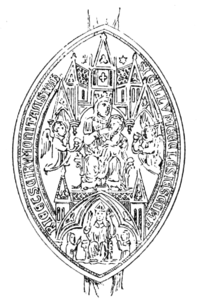Facts
Feastday: August 30
St. Rumon, also known as Ruan, Ronan, and Ruadan, was probably a brother of BishopSt. Tudwal of Trequier, but nothing else is known of him beyond that he was probably an Irish missionary and many churches in Devon and Cornwall in England were named after him. Some authorities believed he is the same as the St. Ronan (June 1) venerated in Brittany and believed consecrated bishop by St. Patrick, but others believe that he and St. Kea were British monks who founded a monastery at Street Somerset. Feast day is August 30.
More about St. Rumon from Wikipedia

Seal of Tavistock Abbey affixed to a lease of 1542, showing St Mary with the infant Jesus seated on her lap, with a mitred abbot seated below, all surrounded by the legend: SIGILLUM ECCLESI(A)E S(AN)C(TA)E MARI(A)E ET S(AN)C(T)I RUMONI TAVISTOCK ("seal of the Church of Saint Mary and of Saint Rumon of Tavistock")
Tavistock Abbey, also known as the Abbey ofSaint Mary and Saint Rumon, is a ruinedBenedictine abbey in Tavistock, Devon. Nothing remains of the abbey except the refectory, two gateways and a porch. The abbey church, dedicated to Our Lady and St Rumon, was destroyed by Danish raiders in 997 and rebuilt under Lyfing, the second abbot. The church was further rebuilt in 1285 and the greater part of the abbey between 1457 and 1458.
Contents
- 1 History
- 1.1 Dissolution
- 1.2 Saint Rumon
- 1.3 Cornwall
- 2 Burials
- 3 See also
- 4 Notes
- 5 References
- 6 Further reading
History

Remains of the cloister arches

The abbey still house
The abbey was founded in 961 by Ordgar, Ealdorman of Devon, and completed by his son Ordwulf[1] in 981, in which year the charter of confirmation was granted by King Æthelred II (c.968-1016)The Unready, nephew of Ordwulf. It was endowed with lands in Devon, Dorset andCornwall, and became one of the richest abbeys in the west of England.
Abbot Lyfing and his successor Abbot Ealdredboth became Bishops of Worcester, and the latter is said to have crowned King William the Conqueror. The thirty-sixth abbot, John Dynynton, was granted leave in 1458 to use various pontificalia and the mitre, which latter gave him a seat in Parliament.[2] The thirty-ninth abbot, Richard Banham or Baynham,[3]was made a lord of Parliament by King Henry VIII in 1513.
Dissolution
In 1538 the last abbot, John Peryn, together with twenty monks, surrendered the abbey to the king, receiving a pension of a hundred pounds. The abbey was the second wealthiest in Devon at the time of the Dissolution of the Monasteries (1536–1541), estimated at £902, only very slightly behind the wealth of Plympton Abbey. Both were far wealthier than the next wealthiest, Buckfast Abbey, with an annual income of about £460.[4] In 1540 the Abbey and its lands were granted by King Henry VIII to John Russell, 1st Baron Russell(created in 1550 1st Earl of Bedford).[5] The Russell family long maintained a close connection with Tavistock, and in 1694 the family received the additional titles ofMarquess of Tavistock and Duke of Bedford. They erected many 19th-century public buildings and statues in the town at their own expense. In 1810 John Russell, 6th Duke of Bedford built to the designs of Sir Jeffry Wyattville a private residence named Endsleigh Cottage at nearby Milton Abbot, a former manor belonging to the Abbey. It was a largecottage ornée used as a summer holiday home, still standing but sold in the 20th century by the Russell family.[6] It is now the Hotel Endsleigh, managed by Alex Polizzi and owned by her mother.[7]
Saint Rumon
St Rumon, also known as Ruan, Ronan, and Ruadan, was probably a brother of St Tudwalof Tréguier, but nothing else is known of him beyond that he was probably an Irish missionary and many churches in Devon and Cornwall in England were named after him. Some authorities have identified him with St Ronan (1 June), venerated in Brittany, but others believe that he and St Kea were British monks who founded a monastery at Street, Somerset. Feast day is 28 or 30 August (at Tavistock). The translation of St Rumon is celebrated on 5 January.[8]
Cornwall
The abbey had considerable land holdings in Cornwall and three churches there are dedicated to St Rumon: Ruan Lanihorne, Ruan Major and Ruan Minor. In Domesday Book the abbey held the manors of Sheviock, Antony, Rame, Tregrenna, Penharget and Tolcarne, while four other manors formerly theirs had been taken by Robert of Mortain. Only Sheviock was in the hands of the abbey while Ermenhald held five manors from it. Sheviock was worth 60s per annum and the holdings of Ermenhald were worth in all £8-15s. These were the same values as formerly suggesting the monks were good at administering their estate.[9] These lands in the extreme south-east of Cornwall were the reason for that district being part of Devon from the medieval period until 1844.
In early times the Isles of Scilly were in the possession of a confederacy of hermits. King Henry I gave the hermits' territory to the abbey of Tavistock, which established a priory onTresco that was abolished at the Reformation.[10]



